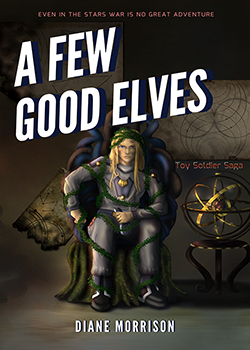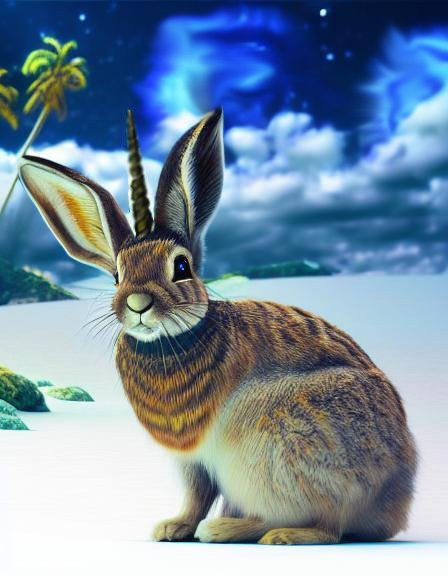Al-Miraj ([ ahl-miʿRAHZH ] | / ɑl mɪˈrɑʒ /)
An al-miraj is a lagomorphic creature with yellow or golden fur, and a spiralling horn like a unicorn's, growing out of the front of its head. It is said that all animals that set sight upon it will flee.
Always appreciative of bad jokes and worse puns, starfarers have nicknamed the creature the "stabbit."
Basic Information
Anatomy
The "stabbit" is usually described as a rabbit or hare with yellow fur and a black, spiralling horn, resembling that of a unicorn, which grows out of its occipital bone.
Fur colours seem to range from pale wheat to dun to golden to honey-brown, and may show white patches or even be dappled, striped, or spotted in dark brown, black, or grey. The ears are usually described as being proportionately long, and may be black or brown tipped.
The horn is typically described as having the colour and texture of polished ebony wood.
Otherwise, al-miraj share the usual powerful hind legs, claws, sharp incisors, long ears and fluffy tails of all lagomorphs, allowing them to chew through even the toughest materials given time, evade predators by outrunning and out-hopping them, and fight when they must.
Genetics and Reproduction
Speculation on the possible relationships of cryptid lagomorphs is a hot topic in naturalism currently. Some theories postulate that al-miraj and jackalopes are essentially the same creatures, except for the numbers of horns. Naturalists who have actually seen the two creatures believe otherwise.
Like other lagomorphs, al-miraj seem to breed frequently and bear many young at once, often from several different bucks. A small fluffle in captivity on Telasia breeds ten months out of a standard year, and the gestation period is about six weeks long. Each doe produces up to four litters a year, ranging from one to five kits, which they nurse in shallow dirt nests that are formed by scraping hollows in the ground. These hollows are called "forms" and are typically lined with flattened grass, suggesting they may be more closely related to hares. Whether this is typical of all "stabbits" or not in unknown.
Young are born live, fully furred, and with eyes open, and a soft nub of a horn that begins hardening immediately after birth. Its horn will grow to its full size -- about a third of the length of the al-miraj's body -- within the first year. The horn is not used in scuffles between the creatures, although bucks fight for dominance and mates, just as other lagomorphs do. This appears to be an adaptation strictly for defense of itself and its fluffle against predators.
Some al-miraj are said to have venomous horns, though there is no evidence of that among the captive warren.
Ecology and Habitats
Al-miraj seem to prefer coastal habitats. They can be found throughout the Core Worlds on islands and beaches in semi-tropical climates.
Dietary Needs and Habits
Although there is no such thing as a strict herbivore, the al-miraj comes close. Its diet mostly consists of grasses. The captive warren seems to share the archetypal lagomorphic love of carrots and bananas.
The al-miraj will eat a predator it had to fight if it can, however, and this may have given rise to reports that the animal is carnivorous. It is unclear why the al-miraj reacts in this particular way; perhaps the life-and-death conflict produces a "survival mode" instinct, something like how snowshoe hares will scavenge their own predators in the depths of Arctic winters.
Behaviour
The al-miraj appears to be fairly typical of other hares and rabbits; alert, twitchy, responsive to danger in its environment, and preferring flight over fight. Socially, it organizes somewhat between hares and rabbits; while it dwells above ground as hares do, it appears to gather in "fluffles" that interact, scuffle, interbreed, and protect each other from predators.
However, it has one key difference from other lagomorphs; if spotted by its prey, rather than freezing or "playing dead," it will stare the predator down. It dips its head to aim its horn at the threat, meets the possible predator's eyes, and waits. If attacked, it will charge and thrust with its horn before resorting to other lagomorphic fighting methods; biting, clawing, and kicking with its powerful back legs.
While this behaviour has resulted in more than one "stabbit" being trampled by a horse, it is a surprisingly intimidating behaviour, and may have been the origin of the belief that other animals would flee before an al-miraj.
Additional Information
Uses, Products & Exploitation
Al-miraj are reputed to be quite tasty and make an excellent soup stock. Their horns are sometimes used in unique scrimshaw art. Their fur is valued in clothing manufacture for its softness and unique appearance.
Perception and Sensory Capabilities
The al-miraj has all the advantages of a lagomorph's keen senses; keen colour vision, widely-spaced eyes, excellent hearing thanks to its long ears, long whiskers to feel its way in the dark. These all aid the creatures in evading their many predators.
Don't forget that you can click on the blue compass on the left to access the Table of Contents at any time!







Comments